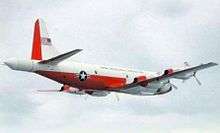VXS-1
| Naval Research Laboratory Military Support Division Scientific Development Squadron ONE (VXS-1) | |
|---|---|
|
VXS-1 Insignia | |
| Active | December 2004 – present |
| Country | United States |
| Branch | USN |
| Garrison/HQ | NAS Patuxent River |
| Nickname(s) | Warlocks |
| Commanders | |
| Commander | CDR Jeff Plaisance |
Scientific Development Squadron ONE (VXS-1) is a U.S. Navy military support squadron that conducts numerous single-aircraft deployments around the world in support of a wide range of scientific research projects.
Mission statement
To provide heavy lift aircraft capable of supporting scientific research projects around the world for Naval Research Laboratory, Department of the Navy, U.S. Department of Defense activities, as well as other U.S. government agencies that contribute to Naval Research.
History
Formerly known as Flight Support Detachment, Scientific Development Squadron ONE (VXS-1) was established 13 December 2004, as commissioned by the Office of the Chief of Naval Operations, Notice 5450.[1]
Fleet Operations
Manned by Navy officers, enlisted sailors and government and private civilian personnel, the squadron is responsible for the maintenance and security of three uniquely configured NP-3D Orion turboprop research aircraft, two Beechcraft Super King Air RC-12 aircraft, over 200 unmanned aerial systems and an American Blimp Corporation Lighter-Than-Air (LTA) airship (MZ-3A) transferred to VXS-1, October 2009.[2]
Located on board the Naval Air Station Patuxent River, Maryland, VXS-1 is responsible for the training, qualifications, and proficiency of all assigned personnel, as well as the maintenance of the research aircraft, and detachment coordination.
Missions

2004 – The Detachment supported the Antarctic Sea Ice Campaign, flying missions in and around what was formerly known as the Palmer Peninsula on the Antarctic continent. The mission purpose was the evaluation of spatial variability to fully assess how accurately sea ice parameters can be derived based on a study of new ice emissivity, heat, and salinity fluxes over coastal waters and a determination of precise locations of ice edges.[3]
2006 – VXS-1 flew the "Rampant Lion I" survey conducted by Naval Research Laboratory and U.S. Geological Survey scientists as part of an integrated remote sensing survey, mapping approximately two-thirds of the country of Afghanistan.[4]
2008 – The team flew “Rampant Lion II.” Built on data obtained in 2006, the team's modified NP-3D Orion aircraft assisted scientists with a dual focus – developing advanced geospatial collection; and analysis techniques to support the warfighter and economic infrastructure development in Afghanistan.[5]
References
- ↑ "OPNAV NOTICE 5450" (PDF). Department of the Navy. 13 December 2004. Retrieved 2010-07-14.
- ↑ "NAVAIR" (PDF). Department of the Navy. 15 May 2010. Retrieved 2010-07-14.
- ↑ Rubino, Lt. John A. (2005). "Flight Support Det becomes VXS-1". Naval Aviation News. Retrieved 2010-07-14.
- ↑ Thompson, Rick (2006, 26 October.). "VXS-1 completes geophysical mapping project in Afghanistan". DCMilitary. Retrieved 2010-07-14. Check date values in:
|date=(help) - ↑ "NRL's Rampant Lion ll Survey Builds on Success of Rampant Lion l". Naval Research Laboratory. 26 January 2009. Retrieved 2010-07-14.
External links
| Wikimedia Commons has media related to Scientific Development Squadron 1 (United States Navy). |
